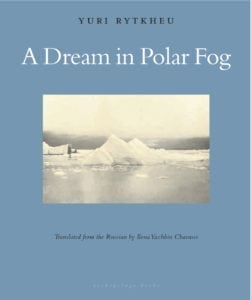
Download this Reading Group Guide as a PDF
A Dream in Polar Fog
By Yuri Rytkheu
Translated by Ilona Yazhbin Chavasse from the Russian
Discussion Points / Questions:
1. Only after the Canadian sailor John MacLennan’s hands are amputated by the shaman Kelena does he begin to see the Chukchi people as anything more than savages; and only after he is abandoned by his own people to live with the Chukchi does he begin to try to understand them. What does this tell us about loss opening up connections to others? What does it say about the relationship between vulnerability and community?
2. Rytkheu has been compared to writers such as Jack London in regards to the honesty of his descriptions of both people and the environment. The characters in A Dream In Polar Fog seem less like symbols and more like actual people, possessing a variety of motivations and contradictions. The same can be said of each culture depicted. Both modern and traditional ways of life, in turn, are seen as noble as well as brutal. What is Rytkheu saying about the relationship between these two different cultures? Does the straightforward way he writes about them serve to emphasize irreconcilable differences or deep commonalities?
3. Much in the manner of an ethnographic study, A Dream In Polar Fog introduces us to the Chukchi language. We learn words such as chottagin, polog, yarar, and kamleika. We are also introduced to the Chukchi origin story, with Rytkheu sometimes switching perspective from a member of the tribe to John, the Canadian, in order to fully flesh out the details of Chukchi daily life and thought. What differentiates this from an ethnographic study? What might be the advantages or disadvantages of presenting the Chukchi in fictive form?
4. Although the Chukchi are considered an isolated people, at least by Western definitions, they are still aware of contemporary events, such as the Gold Rush in Alaska. How does Rytkheu express this sense of an outside world slowly crowding in on the Chukchi? John MacLennan tells his friend Orvo that “the less we come into contact with the white man’s world, the better.” Is the tide of contemporary events escapable? Is escape even the best option? Taking place in Siberia, the Russian Revolution looms over the novel as well. Does that give the novel a sense of urgency that it would not otherwise have?
Suggestions For Further Reading:
Online:
Andrey Shapran has taken moving portraits of the Chukchi people.
These Chukchi flashcards are a fun way to explore the language.
From Words Without Borders: David Rothenberg created a visual response to Yuri Rytkheu during his own travels to the Arctic.
Listen to a beautiful Chukchi Lullaby.
From Survival International: The Survival For Tribal Peoples’ page for Siberian Tribes.
Print:
Rane Willerslev, On the Run in Siberia. Translated by Coilin OhAiseadha. (University of Minnesota Press, 2012): The story of a young Danish anthropologist who travels to Siberia in order to establish fair trade cooperatives with indigenous hunters.
Alun Anderson, After the Ice. (Smithsonian, 2009): Alun Anderson explores how changes in global climate will affect the geography, animals, and people of the Arctic.
James Forsyth, A History of the People’s in Siberia: Russia’s North Asian Colony 1581-1990. (Cambridge University Press, 1994): The first ethnohistory of Siberia to appear in English, this account covers Siberia’s history starting with the Russian conquest and continuing through the native rights movement in the 1980s.
Janet Billson and Kyra Mancini, Inuit Women: Their Powerful Spirit in a Century of Change. (Rowman & Littlefield Publishers, 2007): This fantastic study explores how rapid cultural changes have affected the lives of Inuit women.

